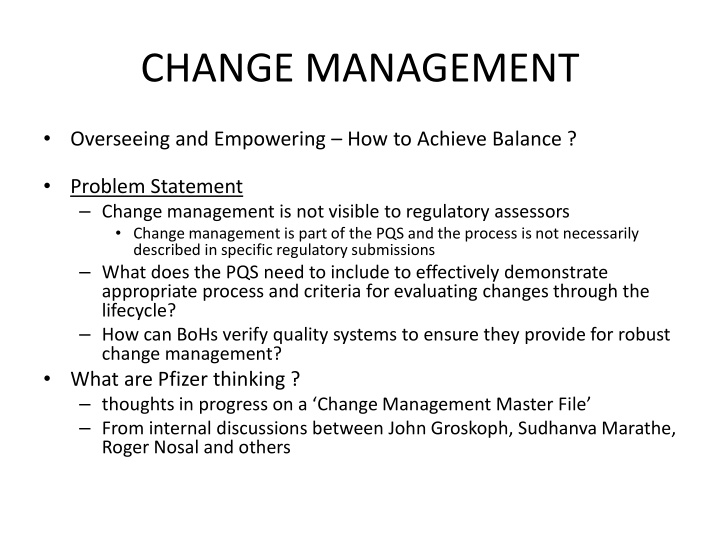



CHANGE MANAGEMENT Overseeing and Empowering – How to Achieve Balance ? • • Problem Statement – Change management is not visible to regulatory assessors • Change management is part of the PQS and the process is not necessarily described in specific regulatory submissions – What does the PQS need to include to effectively demonstrate appropriate process and criteria for evaluating changes through the lifecycle? – How can BoHs verify quality systems to ensure they provide for robust change management? • What are Pfizer thinking ? – thoughts in progress on a ‘Change Management Master File’ – From internal discussions between John Groskoph, Sudhanva Marathe, Roger Nosal and others
Prerequisites to Managing Change • FOUNDATION – Pharmaceutical Quality S ystem – Robust & Management – Framework for managing change, e.g., PCP/ PCR process – Differentiate established vs. non-established conditions – FDA/ EMEA auditable & certified upon inspection – Filter changes based on risk, i.e. in PQS , Notification or P AS • BACKBONE - Robust Product Control S trategy – Control strategy = S um of all matters to be controlled in manufacture – Defined in regulatory application & consistent w/ Established Conditions – PLUS Changes managed via PACMP/Comparability Protocols/Lifecycle MP – Reference to Management Master File
A ‘CHANGE MANGEMENT MASTER FILE’ ? Compiled to describe / outline company or site process for change • management – Can be broader than single product – Can be tailored for product types / specific products (with PACMPs) – Can describe change management for legacy products AND new products Inspectable and ‘referenced’ (not needing assessment and approval) • Product specific components - specific PACMPs - approved • Gives regulators visibility of change management approaches • Can be ‘same’ to all regulatory agencies who adopt • Empowers the company / site quality system • – To make a broad set of specific changes using downgraded reporting (or without prior regulatory apporval) based on robust PQS and QRM – Can be rolled on to suppliers – Can be of especial importance to primary tech transfer site who optimise and then feed-on mature processes to network
Proposal: Change Management Master File • Describes change management process – How changes are assessed and managed • Who is involved • How different ‘ tiers’ of change are addressed and managed • The E-2-E process in the company – Including with suppliers to the company – How risks are assessed • How different changes can be assessed in appropriate ways • S cope? – May be universal – all/ multiple manufacturing sites – OR ‘ site specific’ for a type of manufacturing site(s) – aseptic, packaging/ labelling, S OD, etc. – S haped to ‘ Product type/ product’ • Vx, mAbs, devices, etc.
Managed w/in CBE 30, CBE 0, Prior Approval Notification Type 1B PQS CHANGE MANAGEMENT MASTER FILE Robust Robust & Product & Certified Control Management PQS strategy
Change Management Master File ( MMF ) The Management Master File is not intended for • submission in an application – Cross-referenced in regulatory applications – S upplemented with product-specific Comparability Protocol or PACMP as appropriate – Reviewed upon inspection • Can be built to include expanded multi-product P ACMPs – e.g., facility, network or regulatory change types • Detailed description of the quality systems used to manage changes. – Verified & certified by regulatory authorities – Opportunity to reduce regulatory filing mechanism – Includes knowledge management continuity • Record of risk assessments throughout the life cycle
ite specific changes managed in a MMF S • Facilit y and equipment changes - e.g. environment al change (% RH, t emp et c.) due t o HV AC changes • Network changes • Changes to comply with new reg. requirements e.g. pharmacop change, labelling, Q3D • Generalised changes - Design Space verification ; SM supplier change management • S imilar t ypes of product s – e.g., all solid oral dose roller compacted products • Packaging change for all product s wit hin sit e – e.g., transition to S &T bottle • Change of address (wit hin sit e) t o comply wit h cert ain regulat ory market s • S it e Closure or maj or modificat ions
Regulatory Pathways for Managing Post- Approval Changes Change Management Master File S cope* S ubmit documentation for No approval before making the change Is it (e.g., PAS , Type II covered under Yes Variation) an approved PC or PACMP? Are Yes the results Yes* acceptable? Is it Making Is it related to an a post-approval Yes a maj or Established manufacturing change? S ubmit Condition? change notification and No? make the change Is it (e.g., CBE, Type under a No IB Variation) company’ s No standard change Make the change control Are and report in protocol? Yes Yes the results notification (e.g., acceptable? annual report, Type IA Variation) Mange the change within Quality System (i.e., no dossier update required) * There are potentially two different pathways in this situation, depending on the regulatory system in the country or region.
Recommend
More recommend